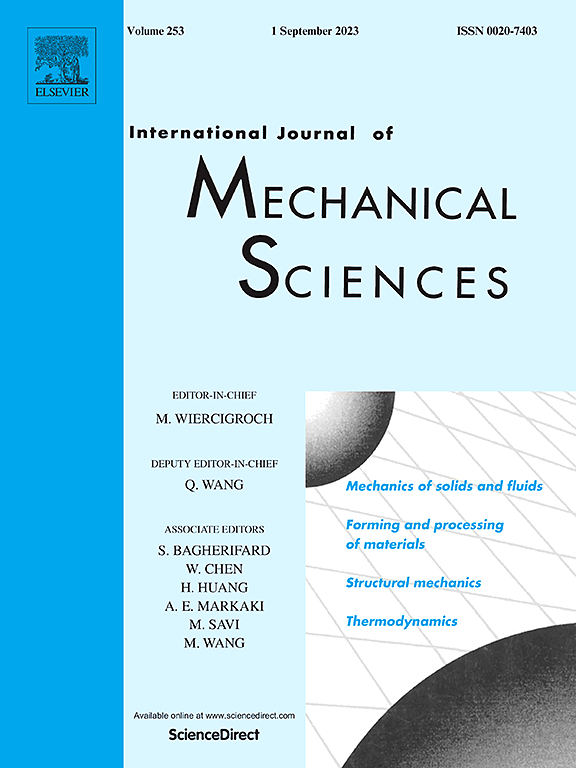Self-excited vibration suppression in floating splined rotor systems via a composite spline ring
IF 7.1
1区 工程技术
Q1 ENGINEERING, MECHANICAL
International Journal of Mechanical Sciences
Pub Date : 2025-07-14
DOI:10.1016/j.ijmecsci.2025.110598
引用次数: 0
Abstract
Floating splined rotor systems with metal splines are susceptible to friction-induced self-excited vibrations under supercritical conditions. To suppress this nonlinear vibration, this paper introduces a novel self-lubricating composite spline design as a replacement for conventional metal splines. The proposed configuration integrates a self-lubricating spline ring between conventional mating internal and external splines, forming a composite structure with two engaging spline pairs (one circular-arc and one involute). A dedicated dynamic model incorporating newly developed spline stiffness and damping formulations is established to give a thorough understanding of self-excited vibration suppression mechanisms. The spline stiffness formulation is derived from deformation compatibility theory and is suitable for both dual-engagement composite spline and single-engagement conventional spline, and the spline damping formulation accounts for both friction-induced damping and material dissipation damping. Comparisons of modal property and dynamic response results validate good accuracy of the proposed models. Both numerical simulation and experimental measurement demonstrate that the composite spline has good self-excited vibration and critical speed resonance suppression capabilities. Intrinsic vibration suppression mechanisms of composite splines are addressed through critical parameter sensitivity analysis. Combinations of higher elastic modulus and lower friction coefficient are desirable for optimal spline ring material selection to enhance suppression performance.利用复合花键环抑制浮动花键转子系统的自激振动
具有金属花键的浮动花键转子系统在超临界条件下容易受到摩擦引起的自激振动的影响。为了抑制这种非线性振动,本文介绍了一种新的自润滑复合花键设计,以取代传统的金属花键。所提出的配置集成了一个自润滑花键环之间的传统配合内花键和外花键,形成了一个复合结构,由两个啮合花键对(一个圆弧和一个渐开线)。建立了一个结合新开发的样条刚度和阻尼公式的专用动力学模型,以全面了解自激振动抑制机制。根据变形协调理论推导出的花键刚度公式适用于双啮合复合花键和单啮合传统花键;花键阻尼公式考虑了摩擦诱导阻尼和材料耗散阻尼。模态特性和动态响应结果的比较验证了所提模型具有良好的精度。数值模拟和实验结果表明,复合花键具有良好的自激振动和抑制临界转速共振的能力。通过关键参数灵敏度分析,探讨了复合样条的固有振动抑制机理。高弹性模量和低摩擦系数的组合是优化花键环材料以提高抑制性能的理想选择。
本文章由计算机程序翻译,如有差异,请以英文原文为准。
求助全文
约1分钟内获得全文
求助全文
来源期刊

International Journal of Mechanical Sciences
工程技术-工程:机械
CiteScore
12.80
自引率
17.80%
发文量
769
审稿时长
19 days
期刊介绍:
The International Journal of Mechanical Sciences (IJMS) serves as a global platform for the publication and dissemination of original research that contributes to a deeper scientific understanding of the fundamental disciplines within mechanical, civil, and material engineering.
The primary focus of IJMS is to showcase innovative and ground-breaking work that utilizes analytical and computational modeling techniques, such as Finite Element Method (FEM), Boundary Element Method (BEM), and mesh-free methods, among others. These modeling methods are applied to diverse fields including rigid-body mechanics (e.g., dynamics, vibration, stability), structural mechanics, metal forming, advanced materials (e.g., metals, composites, cellular, smart) behavior and applications, impact mechanics, strain localization, and other nonlinear effects (e.g., large deflections, plasticity, fracture).
Additionally, IJMS covers the realms of fluid mechanics (both external and internal flows), tribology, thermodynamics, and materials processing. These subjects collectively form the core of the journal's content.
In summary, IJMS provides a prestigious platform for researchers to present their original contributions, shedding light on analytical and computational modeling methods in various areas of mechanical engineering, as well as exploring the behavior and application of advanced materials, fluid mechanics, thermodynamics, and materials processing.
 求助内容:
求助内容: 应助结果提醒方式:
应助结果提醒方式:


